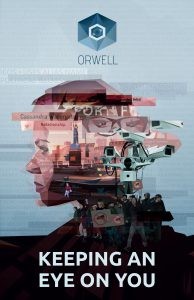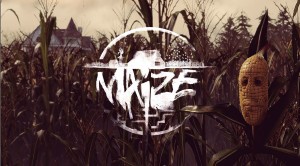Outsider Games Gone Wilde! interview - page 2
After releasing their first adventure Wailing Heights in 2016, Outsider Games from Belfast, Northern Ireland, are currently running a Kickstarter campaign for their latest game, Jennifer Wilde, a supernatural mystery based on a three-part graphic novel series starring a young French artist and the ghost of famed playwright Oscar Wilde. There's still time to check the game out firsthand through the playable demo available, but with the crowdfunding campaign drawing to a close, the hand-drawn black-and-white adventure set in 1920s Paris is in urgent need of additional public support to become a reality. With the outcome of the Kickstarter coming down to the wire, the timing seemed right to catch up with Outsider’s CEO Stephen Downey to dig a little deeper, and discuss all-things-Jennifer Wilde.
Ingmar Böke: Hi Stephen, welcome to Adventure Gamers! Your last game, Wailing Heights, was a musical adventure, and your next, Jennifer Wilde, is going to feature the ghost of famous playwright Oscar Wilde as a playable character. You have quite an interest in unusual projects, don’t you?
Stephen Downey: Thanks for having me, and yes, I always try to do something different with the projects I work on, in both story and mechanics. I want to work on projects that are fun and have a unique take, and can also hopefully pique a potential player's interest with just a few words!
Mechanics-wise, Wailing Heights was a ‘body-hopping musical adventure game’, in which the player used a musical possession wheel to complete song lyrics with inventory items. In Jennifer Wilde, we again offer an innovative take on the classic adventure game inventory, and try do something new.
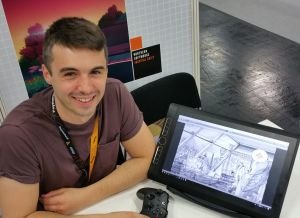 |
Stephen Downey at gamescom 2017 |
With the combination of comic book art style and Jennifer’s role as an art student, the inventory takes the form of a comic book sketchbook. As Jennifer investigates and finds clues, she sketches these in her book, which she can combine and arrange to tell an illustrated narrative that will help her solve a mystery.
And, of course, Jennifer has a very unusual co-star: the ghost of Oscar Wilde. I think the combination of Oscar’s dry wit and egotistical personality, alongside Jennifer’s youth and irreverence, makes for a really unusual ‘team-up’. A lot of witty banter and trouble ensues. When I first heard the concept, I was just so intrigued by its uniqueness and potential.
Ingmar: Jennifer Wilde is based on a comic book series, and you have worked on the comics yourself. Please tell us a bit more about that series and how you got on board.
Stephen: Jennifer Wilde was one of the first series I worked on as a comic artist. I had just finished drawing a story for the Doctor Who spin-off, Torchwood, and sent my portfolio out to several comic publishers looking for work.
I received a reply from Rob Curley, who runs Atomic Diner, a comic publisher based in Dublin, not too far from my own home in Belfast. He has given a lot of Irish comic artists their first gigs, many of whom have gone on to work for Marvel and DC Comics. He sent me the synopsis for the Jennifer Wilde series, which was simply:
At the start of the Jazz Age in Paris in 1921, young French artist Jennifer Chevalier becomes embroiled in death, espionage and revolution, which takes her across the three nations of France, England and Ireland – ably assisted by the ghost of Oscar Wilde.
At that point it was still only an idea he had created, and Maura McHugh was finishing the script for the first issue. This meant I was able to join the project from the beginning, designing the characters, and creating the world for Jennifer to live in.
In fact, the black and white line work with grey inkwash is the style in which I chose to draw the comic, and we’re reflecting that in the artwork for the game.
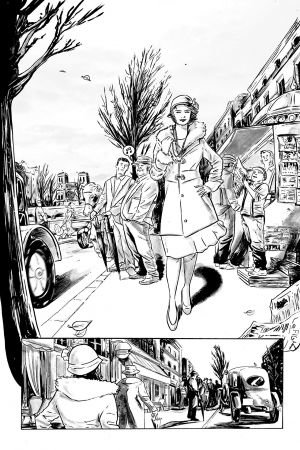 |
The comic (pictured here) has a similar aesthetic to the game |
The comic itself has the same 1920s settings, and even when I was first drawing the pages, I knew it had the perfect Jazz Era setting, brilliant characters and underlying mystery to make a compelling adventure game. The comic series starts with the death of Jennifer’s father, and the game’s story will follow Jennifer’s journey to solve that mystery – though the game will diverge from the comics in parts as we add puzzles and scenarios for Jennifer to solve, spend more time with some of the supporting characters, and players will make choices to create their version of the story.
Ingmar: What can you tell us about the relationship of the two main characters?
Stephen: The relationship between Jennifer and the ghost of Oscar Wilde is a fascinating one, and it will change over the course of the game.
Their first meeting is a chance mistake. Jennifer is attempting to call back the ghost of her murdered father, but accidentally calls back Oscar’s ghost in the hotel room in Paris in which he died. Both Jennifer and Oscar have a dry sense of humor and wit, so their early encounters can seem quite hostile, but this becomes a deep friendship as they work together to solve the murder of Jennifer’s father.
The relationship is complicated by the fact that Jennifer discovers that Oscar and her father had a secret affair together. Through her partnership with Oscar, she is now discovering more about her father after his death than she knew while he was alive. Jennifer is a very ‘modern’ woman for the 1920s, an open-minded, free bohemian spirit, and she will find that perhaps she and her father had more in common than she thought, but he was held back by the shackles of the society he lived in.
These revelations also have a very meaningful impact on Jennifer and her mother’s relationship, but I don’t want to give away the whole story...
Ingmar: In what ways is the gameplay going to differ depending on whether players are playing as Jennifer or the ghost of Oscar Wilde?
Stephen: Both Jennifer and Oscar have their own unique skillset, and to solve some of the more intricate puzzles, players will need to combine the skills of both characters.
For example, although Jennifer can talk to ghosts, it would seem very odd if she walked up and started talking to a corpse in front of the gendarme. To avoid the possibility of Jennifer being sent to an asylum, Oscar has the job of approaching invisibly and chatting to some of the spirits, passing that information back to Jennifer. But, of course, Oscar won’t be able to talk to any of the living people in the game.
Oscar, being an intangible spirit, may also be able to reach areas that Jennifer can’t, though he is tethered to her, so he can’t stray too far.
Inventory items and the sketchbook narrative will all be the purview of Jennifer, although Oscar will often give his dry opinion, whether wanted or not.
Ingmar: Your Kickstarter page says that the choices players make are going to have an impact on the outcome of the story. Please explain that.
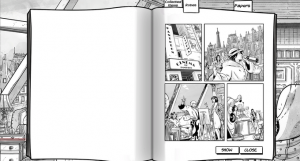 |
Jennifer's hand-drawn sketchbook will be an integral part of the investigative progress |
Stephen: There are few different ways that your choices come into play. One aspect will be character building, and the story opportunities that presents. For example, perhaps you will choose that Jennifer prefers to date women, and as your story plays out, Jennifer’s backstory reflects this, as do the opportunities for romantic outcomes in the story.
The other aspect is direct consequences, and without any spoilers, the fate of certain characters will depend on the actions that Jennifer, and the player, make throughout the story. It won’t affect whether you can solve the mystery, but the player’s sense of morality and justice will have an effect on where key characters end up in the story. The life and death of certain characters will be in the players’ hands...
Ingmar: Can you give an idea of the different types of puzzles that you have in the game?
Stephen: As a game designer, I’ve created the puzzles in four main categories: sketchbook, dialogue, traditional inventory and environmental. Though, of course, these do cross over.
The comic book sketchbook mechanic will be the core method for solving the overall mystery. This is similar to the ‘notepad’ inventory in games like The Blackwell Legacy and Kathy Rain, but we add our own visual spin on this. It is presented as a series of narrative sketches that Jennifer must investigate, collect, combine and arrange in sequence to create a comic book-like narrative that will help her solve the mystery of her father’s murder.
Jennifer’s sketchbook can also store small items in the back, such as leaflets and flyers that she will need to use as more traditional inventory items. An example of this is the ‘wanted poster’ puzzle we have in our demo.
Dialogue puzzles are present; after all, with Oscar Wilde a protagonist in the story, we need to include his literary wit and charm (and, of course, Maura’s great script). There will be less of these than we had in Wailing Heights though, to make room for more varied environmental puzzles.
 |
Stephen hard at work on Jennifer Wilde... |
These environmental puzzles will usually be single-screen set pieces that you need to explore and solve. For example, you can see in our trailer a suitcase with a combination lock that Jennifer finds in her father’s hotel room. We want to tie a lot of these puzzles into Jennifer’s personal story, so to find the combination, she will need to investigate her father’s history. What numbers and dates are important to him? What correspondence can she find that will reveal these, and what will she discover along the way?
Ingmar: What’s your approach when it comes to the difficulty level of the puzzles?
Stephen: I know it is a cliché to say, but I want the player to do some proper ‘detective-work’. Our previous puzzles in Wailing Heights were purposely designed to be ‘mainstream’, so with a little exploration you could find the solution.
With Jennifer Wilde, we wanted to make a game directly for the adventure game audience, so the puzzles will require a bit more thinking. You may prefer to have a pen and paper with you, for puzzles that integrate nicely with the narrative.
Now, that said, I don’t mean really obtuse puzzling. It’s not a Grim Fandango situation. A comparative example we are aiming for might be some of the logical puzzles of games like Broken Age (I really like their variation on the ‘combination code’ that Mother constructs to let you into the control room) and Kathy Rain (the mausoleum puzzle is a recent highlight of my adventure gaming).
The puzzle we have in the demo is mostly a tutorial, and we’ll mix more straightforward puzzles like these with more narrative and layered puzzles. We are working hard to make sure they all have logical solutions and satisfying conclusions.
Ingmar: What other games have influenced the design of Jennifer Wilde?
 |
... but who can work when the adorable Saffie is in studio?! |
Stephen: I was referred to the Blackwell saga after mentioning to someone that we were planning to adapt Jennifer Wilde. I hadn’t played any of the Wadjet Eye games before that, but I’ve become a fan since. The Blackwell series share a few similarities with Jennifer Wilde in a way, and it showed that the format of a young protagonist and her ghost friend can work in an adventure game format. This may also have been the first time I played the ‘notebook inventory’ type of game (although I can’t be sure) and it helped refine some of the ideas I was formulating around Jennifer’s comic sketchbook.
I mentioned Kathy Rain earlier, and as a recent example, it helped show me that adventure game fans will allow me to design puzzles that are a little more layered. I was wary that current players want a game to be easy, and that true problem-solving would put players off a game, but Kathy Rain has given me the confidence to come up with puzzles that require thinking and aren’t just a matter of walking around and trying every inventory item until you get the right combination.
Ingmar: When I played the demo, I was under the impression that it was smoother to navigate Jennifer with the WASD keys, instead of using the full mouse control. Would you say that the combination of keyboard and mouse is going to be the ideal way play of playing Jennifer Wilde?
Stephen: The demo is still a work-in-progress, but my own personal preference is to play primarily with mouse, and avoid WASD altogether, so the game is actually designed equally for both. It still needs a fair bit of tweaking to get the balance right, especially how Jennifer moves around the environment with the mouse controls, and we are actually working on a control scheme that should allow the player to use just mouse smoothly, without any keyboard input at all, if that is their preference.
Ingmar: When I think of Paris in the 1920s, Midnight in Paris by Woody Allen comes to mind, which is one of my favorite movies. One thing I love about the movie is its way of portraying the vibe of the art scene back then. What’s your approach for Jennifer Wilde when it comes to the recreation of the atmosphere at the time?
Stephen: The story takes place at the start of the Jazz Era in Paris, so we plan to create an EP of great jazz music to establish the tone, and provide a backdrop to the adventure.
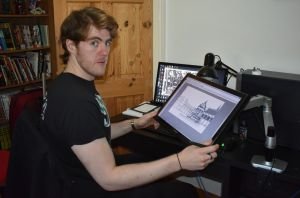 |
Lead artist John McFarlane shows off his work... (You can see where this is going) |
Jennifer will also be studying art at the time Fauvism and modern artists were gaining popularity and Charlie Chaplin was in the cinema, so of course plays from Oscar Wilde were widely performed. References will be scattered across the game, but players shouldn’t feel they need any prior knowledge going into the game; they are just cultural touchstones for our world building.
I think you will also notice than John McFarlane, our lead artist, has done a tonne of research into the look and feel of 1920s Paris, and his detailed scenes capture the feel with his illustrative line work reminiscent of the era.
Ingmar: I remember that when we talked at gamescom last year, there was a notion of doing Jennifer Wilde as an episodic series. That’s not the plan anymore, right?
Stephen: That’s right, we want to tell Jennifer’s story as one complete game. Originally we had considered an episodic approach, but we’ve seen from Wailing Heights that although there may be a tail for adventure game sales, it might take a while before we raise enough revenue to fund the second episode, which would mean a long wait for players to play the conclusion.
This is why we are turning to Kickstarter. We want to raise funds to tell the whole story in one game, and to the level of detail and polish it deserves.
Ingmar: What were the biggest lessons that Wailing Heights has taught you?
Stephen: How long do we have? We have learnt a lot of lessons!
From a production standpoint, our biggest lesson was concerning the audio recording. Originally the game was not designed to have any voice acting, but when we recorded some test footage for our demo, we thought it added an extra layer of charm to the game, and we could not go back to just text.
 |
... before the irresistable Saffie strikes again! |
However, when the final script came in, with eight playable characters, there were over 5000 lines of dialogue to record. It was beyond the scope of what we had originally intended, and we ended up with quite a few dialogue mix-ups and levelling issues. We tried to find them all initially, but as it is possible to play the game multiple ways, and often not hear chunks of dialogue, mix-ups still made it into the game. We have fixed the audio files since, and the game will be updated as we build the console version, but it was a much bigger job than we had intended.
We’ve since completely rebuilt our methods for audio input, and with only two playable characters in Jennifer Wilde, the approach should be a lot more straightforward and error-free.
In terms of game design, we realised that a lot of adventure gamers want a true ‘Point & Click’ with mouse controls. So from the design of the levels, through to the method of interaction and interface, we’re designing Jennifer Wilde to be playable with the mouse, or direct control.
Ingmar: Speaking of ports of Wailing Heights, can you give us an update on the release of the console versions?
Stephen: The PlayStation and Xbox versions of Wailing Heights have been developed. We've passed certification one one platform, which is the final process for release on the console stores, and in the middle of the process with the other. It's a bit more intricate than Steam, and required a fair bit of work. We haven't settled on a release date, and we don't want to release during the busy Christmas season, so my estimate is early next year.
We also have a further console announcement coming soon, but I can't say much about that right now...
Ingmar: It was a pleasure to do this interview, Stephen. I’m wishing you the best of luck with the rest of the Kickstarter campaign for Jennifer Wilde! Do you have any last words for potential backers?
Stephen: Just to say that if Jennifer’s story, the ghost of Oscar Wilde, or a unique take on the classic inventory interest you at all, please do have a look at our Kickstarter campaign, play our free demo and pledge for the game.
We have some really cool rewards, from a copy of the game, to a digital jazz soundtrack and artbook. Physical rewards also include original hand-drawn artwork, and hard copies of the game and comics.
We really want to make this game, and we can only do that if we reach our goal! We need your help to finish Jennifer’s story!






